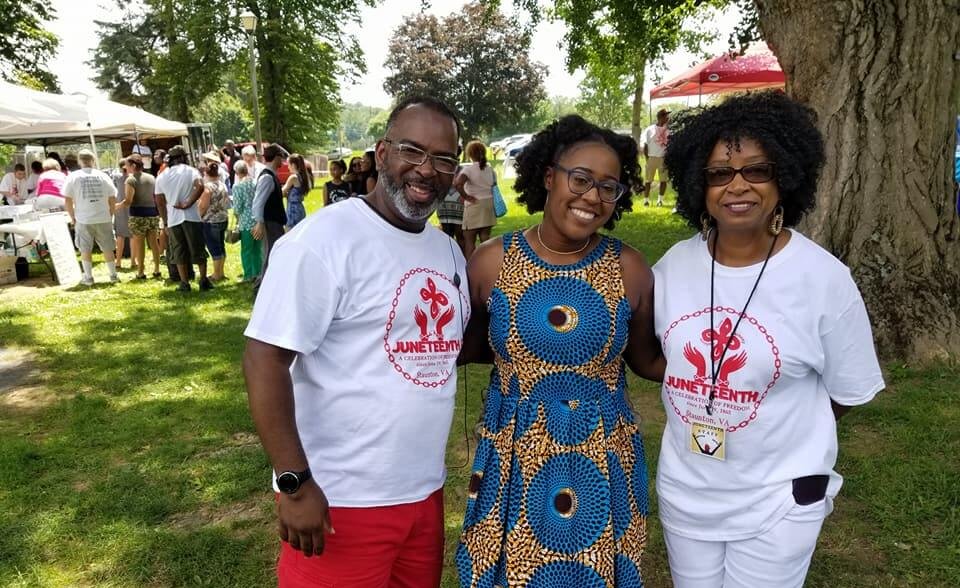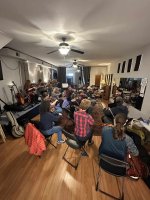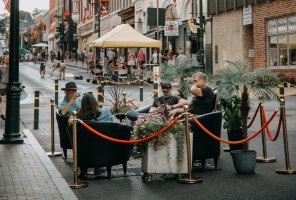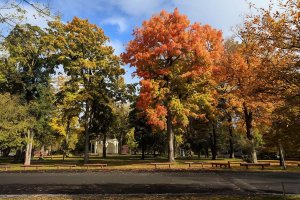
Black-History Month in Staunton
(Published 01/30/2025)
The Black experience is essential to understanding Staunton and the surrounding areas. Read on to learn about how to celebrate Black History Month and other events in Staunton. We’ve also noted important places and citizens and gathered resources for gaining a broader understanding of our city’s Black history, culture, and contributions.
Black History Month at Mary Baldwin
Join the Mary Baldwin University community this February to celebrate Black History Month. Here’s a schedule of MBU events.
For more Black History Month events around the state, check out the schedule on the Virginia Tourism Corporation website.
Juneteenth Celebration
Stay tuned for a Juneteenth celebration in June. The past events have included food, live entertainment, children’s activities, information booths, voter registration, health screenings, and more.
African American Heritage Festival
Staunton’s African American Heritage Festival is a free, annual two-day festival in September is the largest and oldest in the Shenandoah Valley. The event is open to the public and everyone, regardless of heritage, is welcome.
Area History
Before the Civil War, many farms throughout the Shenandoah Valley relied upon the labor of enslaved African Americans. In 1830, only about one-sixth of Staunton’s African American population was free to work as blacksmiths, shoemakers, laborers, domestics, and barbers. After the Emancipation Proclamation, opportunities grew. By the end of the century, Staunton had 26 Black-owned businesses including grocery stores, cabinet-making shops, cobblers, restaurants, barbershops, laundries, and more. Within 10 years, there were nearly 50 Black-owned businesses in Staunton. These included a newspaper, hotel, restaurants, a meat market, an insurance company, a jewelry store, and professionals such as doctors and a lawyer.
Staunton Black Business Collective
The Staunton Black Business Collective actively empowers and tells the stories of Black businesses through collaboration, advocacy, and opportunity to create a thriving community here in Staunton. Want to support a local Black-owned business?
Museums and Research
Booker T. Washington Museum and Library
The Booker T. Washington Museum and Library contains photographs, articles, books, yearbooks, and memorabilia like sports trophies and letterman jackets. It is housed in the Booker T. Washington Community Center, Staunton’s former segregated high school. The school educated Black students for 30 years before Staunton’s schools were finally integrated in 1966. The school served as both an educational space and a public meeting place for the African American community. It hosted social events, voter registration, and adult night classes. The building has been listed on the National Register of Historic Places since 2014.
Frontier Culture Museum’s West African Farm Exhibit
The Frontier Culture Museum’s living history farms educate today’s visitors by recreating the past. The West African Farm exhibit “explores the cultural contributions of African captives who were brought to Virginia in the 1700s.” Captives from many ethnic groups came from all over Africa, but many were Igbo from the West African Coast. The West African Farm demonstrates how free Igbo people lived in Africa in the 1700s. Visitors can learn about history, architecture, farming, cooking, folklore, pottery, weaving, and more.
The museum maintains an archive of lectures developed during the Covid shutdown. They explore various topics, but several relate to the area’s Black experience. Visit YouTube to see Unfree Labor in Early Virginia, Black Lives at Natural Bridge, West Africa and the Slave Trade, and Igbo/West African Masquerade Culture and the Dynamics of the African Diaspora Carnivals.
Woodrow Wilson Presidential Library & Museum
Woodrow Wilson and a number of other presidents have been criticized for their attitudes on race and the history of slavery that surrounds them. The Woodrow Wilson Presidential Library & Museum explores the topic of Wilson and race with several resources on their webpage.
Staunton/Augusta County African American Research Society
Want to learn more about the general and family history and culture of Black people in Staunton? Visit the Staunton/Augusta County African American Research Society’s website for resources. The society’s mission “is to research, develop and maintain an ongoing written, pictorial and multimedia archive of the African American experience in Staunton and Augusta County from its early settlement in 1738 to the present by focusing on education, business, politics, religion, military service, and cultural experience.” The society has worked to gather genealogical records from the library as well as oral histories from older citizens.
Laten Ervin Bechtel’s In Their Words: Growing Up In Segregated Staunton and Augusta County, Virginia
Laten Ervin Becktel has delved into the area’s history of segregation by conducting interviews with 30 African Americans who grew up in segregated times. In this 300-page oral history, Bechtel records an important, and often overlooked, side of local history and shows racial discrimination through the eyes of those who lived it. Available in the Staunton Public Library.
Notable Staunton Addresses
- In 1946, Montgomery Hall Park became one of only two Virginia parks dedicated to African American use, and people traveled long distances to visit. The park remained segregated until 1969. Learn about the park’s history by watching the Woodrow Wilson Birthplace and Presidential Library’s 2008 Montgomery Hall Park Project.
- The congregation of Allen Chapel A.M.E (African Methodist Episcopal) worshipped in various places before the original church was built at 921 West Beverley Street. The first Black church west of the Blue Ridge is also the site of the city’s first Black choir and first Black school for adults.
- Fairview Cemetery is a predominantly African American cemetery located in northern Staunton that was founded in 1869. The Lambert Street location was outside city limits at the time and part of a Black community called Sandy Hollow.
- The masonic lodge on East Beverley and Market Streets was incorporated in 1882. Staunton’s “Colored Masonic Mount Zion Lodge, no.18” is one of the oldest African-American masonic lodges in the U.S. The nearby Cabell House (654 E. Beverley Street) is the last exposed-log structure in Staunton. It was built in 1869 by Edmund Cabell, a “free man of color,” and owned by three generations of his family.
- Dating back to the 1860s, Uniontown is a historically Black neighborhood located along the C&O railroad tracks. In its heyday, the community boasted homes, a school, a church, stores, and a vibrant culture. Restrictive zoning in the 1960s limited the community’s growth. Subpar utility and sewage systems plus the demolition of an access bridge caused many residents to leave the area. Many buildings fell into ruin. Staunton’s city council and planning commission are in an ongoing discussion/neighborhood plan about how to revitalize or develop the area..
Notable Black Stauntonians
- Robert Campbell was born free in 1794. After serving in the War of 1812, he moved to Staunton and opened a barbershop on Beverley Street. His successful business allowed him to buy five downtown buildings and he was considered wealthy by the standards of the times.
- Willis McGlascoe Carter was an NAACP leader who was born into slavery in 1852. He became a principal in Augusta County’s segregated public schools. He led the Augusta County Teachers’ Association and edited the Southern Tribune, an African-American newspaper. Carter helped create the Negro Industrial and Educational Association of Virginia. He’s buried in Fairview Cemetery.
- Born in 1898, Dr. Charles J. Waller served as regional vice president of the National Medical Association. He practiced medicine in Staunton for many years without hospital privileges. Later, he became a member of the King’s Daughters’ staff and was elected president. He was also the first African-American to run for Staunton’s city council.
- Captain William Green Jr. was born in 1920 and graduated from Booker T. Washington High School in 1939. He joined the U.S. Army Air Corps and became one of the famed Tuskegee Airmen, one of our country’s first Black aviators. He flew 123 wartime missions in Europe and earned a Distinguished Flying Cross, an Air Medal with six oak leaf clusters, E.T.O. ribbons with three battle stars, and the Purple Heart.
- Born in 1940, Rita Wilson was Staunton’s first Black councilwoman. She served 16 years as a member and vice mayor of the city council. She also served on the school board and the board of the Frontier Culture Museum.
- Alice Woods moved to Staunton in 1987 from NYC. She serves on Staunton’s city council and is a certified nursing assistant who works with Staunton’s senior population and several non-profit organizations.
- Kenneth Venable is the first African-American to serve as the Staunton school board chairman. Born and raised in Staunton, he worked for 40 years in sales and marketing before returning to Staunton. Venable has held many Staunton leadership positions: President of the Staunton Education Foundation, Vice Chairman, Board of Trustees, Frontier Culture Museum, Past Chairman, Valley Career & Technical Center Board, Past Chairman, Staunton Redevelopment & Housing Authority
View our African American Heritage Brochure for more information.
Newsletter Sign-up
Stay up to date on the latest and greatest happening in Staunton.


